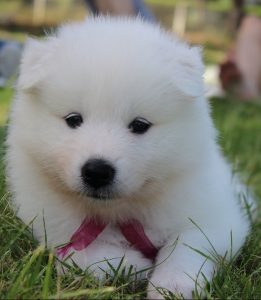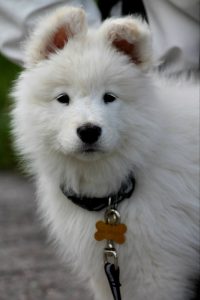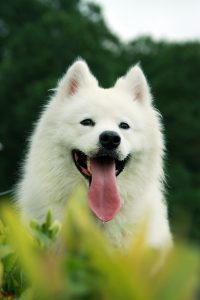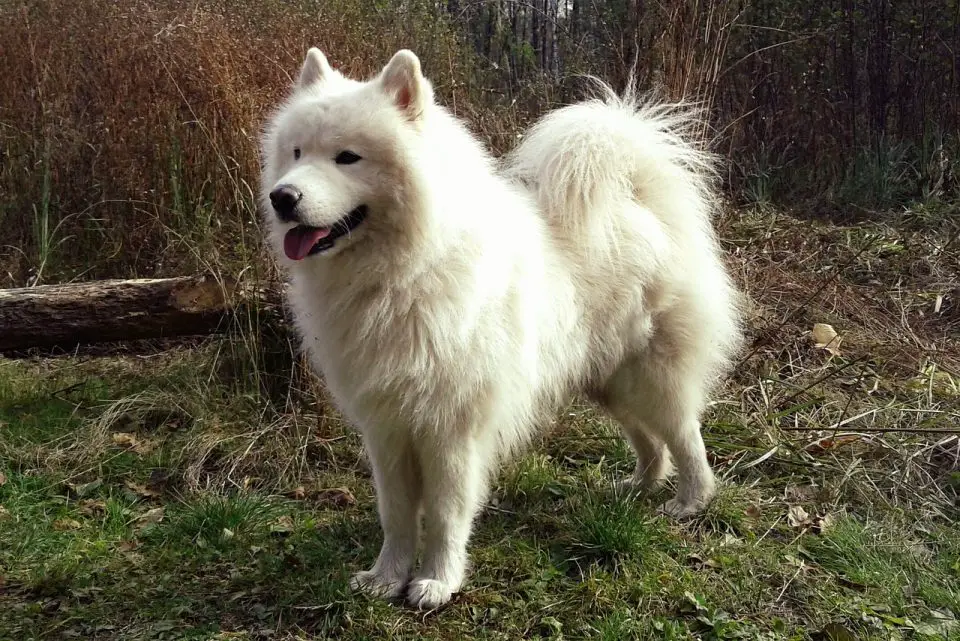When it comes to picking out the perfect pet to adopt into your family, if you’re short on time or have allergies, you may shy away from dogs that have a thick, full coat.
However, by learning about the history and coat of certain thick-furred breeds like the Samoyeds, you can learn how to manage and control their shedding.
Short History of Samoyeds
Samoyeds get their name from a group of semi-nomadic people called the Samoyede who migrated from Asia to Siberia.
It is in Siberia, where the temperature reached below freezing most nights, that the Samoyed was bred as both a work dog and a companion.
Whether they were hauling heavy loads as sled dogs, hunting or acting as guard dogs, and sleeping with their owners at night to increase warmth inside the homes, Samoyeds were included in the everyday life of the Samoyedic people, forming a close knit bond.
It wasn’t until the late 18th century that Samoyeds were introduced to England thanks to Arctic explorers.
The breed was first recognized by the American Kennel Club in 1906.
What is a Samoyed’s Coat Like?

The coat, other than the happy, bright expression, is probably one of the first things you’ll notice about a Samoyed.
Thick, white, and fluffy, the Samoyed appears to be more cloud or snowbank than dog.
The thick double coat is comprised of a short, soft wool and is covered by longer, rougher hairs to form the top coat.
The top coat, to meet the standards set by the American Kennel Club, should be free of curl and stand straight out from the body.
There are also gender differences, with females sporting a coat that is shorter and softer than their male counterparts.
You’ll also notice a slight silver sheen that indicates whether or not the coat is healthy.
Do Samoyeds Shed?
While it comes as no surprise, Samoyeds do indeed shed.
How Much do Samoyeds Shed?
The American Kennel Club says that Samoyeds are seasonal shedders, but there’s a bit more to it than that.
It is true that Samoyeds shed more during certain seasons, however, you can expect minimal shedding year-round – no surprise with a fluffy coat that thick.
When do Samoyeds Shed the Most?
Time of year
As you most likely already know – especially if you’re a seasoned dog owner – is that nearly all breeds of dogs experience what is called a season ‘blow out’.
This is when they switch their coats from winter to summer in the spring and then from summer to winter in the fall.
While this is the rule of thumb, however, it can vary between breeds according to different factors, with some breeds only experiencing one of these blow outs.
For Samoyeds, whether or not your specific dog experiences one of two blow out depends on two things. The first determining factor is their gender.
Males, whether they have been neutered or not, will only blow their coat once a year during the spring as they prepare their summer coats.
If your Samoyed is a female, whether their blow their coat once or twice a year depends on if they are spayed or not.
A spayed female will only blow her coat once a year, while an unspayed female will blow her coat twice a year.
Puppy coat
If you buy your Samoyed from a breeder at six weeks old, there’s one thing that you’ll notice almost immediately.
Their fur is extra soft and wispy, much like a human baby’s hair. While this baby fur is nice and cuddly, it won’t last forever, sadly.
When your pup is a few weeks old – around 3 to 6 months – you’ll notice that they are shedding much more frequently than usual, large balls of puffy white hair cluttering what seems to be every inch of your floor.
While this may be a bit on an annoyance at first, don’t worry, it won’t last forever.
You puppy must blow out their coat when they are growing up, otherwise they would keep their puppy coat forever, and, even though it’s super soft, a puppy coat won’t provide your Samoyed much protection.
Health Reasons for Increased Shedding in Samoyeds
There are also a few reasons why your Samoyed is shedding more often than usual that aren’t so natural.
 Poor diets
Poor diets
Fur needs nutrients to grow and stay healthy. That’s no surprise, especially with a coat as thick and luscious as a Samoyed’s.
If you notice a sudden increase in shedding, take a look at the nutritional information on the back of your dog’s food bag.
If the first ingredient listed is some type of grain or filler, you need to switch to a food that meets all of the needs of your dog by including healthy, dog-friendly ingredients that are easy to digest.
Skin irritation
Whether caused by an allergic reaction to shampoo, anxiety, or just dry skin, any type of skin irritation has the potential to lead to excessive shedding.
This is because your dog will begin to scratch, gnaw, and lick at the area to ease the discomfort, an action which will eventually lead to hair loss.
Parasites
Fleas, ticks, flies, worms – you name it. There are plenty of parasites that can infect your pup, causing issues inside and out, including excess shedding.
Make sure to talk to your vet for diagnosis and treatment plans if you suspect that this is why your dog is shedding more than usual.
How to Combat Samoyeds Shedding
Before getting into how you can prevent your Samoyed from shedding – or at least fight the excess amounts of hair that will pile up in your house – let’s talk about the one thing that you absolutely should not do: shave his or her coat.
Do you remember when we were talking about the breed standard coat earlier, and I mentioned that Samoyeds have a double coat?
Well, this means that, if you shave them rather than trim the hair, you’ll damage their double coat.
It won’t grow right anymore, and that can leave your dog vulnerable to the elements. Instead, regular grooming is key.
Brush your Samoyed as often as you can but make sure that you brush him or her at least three or four times a week.
The more often you brush them, the less hair that will end up on your floor.
Brushing will also help distribute your Samoyed’s natural oils, keeping their fur healthy which, in the long run, will help prevent shedding.
You should also wash him or her once or twice a month to help prevent build up of dirt and debris in their coats.
While grooming can be a time consuming tasks for breeds like the Samoyed, investing in the right equipment can help you fight shedding.
Equipment Help to Combat Samoyeds Shedding
You’ll need quite a few tools to help groom your Samoyed to combat shedding, as the care they need week to week may vary.
One week, they may just need a quick brush down with a slicker brush (discussed more below) to remove an excess loose hair, while other weeks, you may find that you need to bathe them and use a dematting tool to get rid of any and all of those tough knots.
Before breaking down the actual tools you will want to invest in, however, here are some other products you may find beneficial.
First, you may want to invest in a grooming table – just like the ones that professional dog groomers use.
While it may seem a bit strange at first, you’re going to spend a large chunk of time each week grooming your Samoyed.
Without a grooming table, you’ll be forced to stay hunched over, hurting your back.
A grooming table will prevent that while also allowing you to easily reach all areas on your Samoyed, and it will help keep them restrained without hurting them.
Next, you may want to consider buying a bottle of detangling spray for your Samoyed.
Their thick coats are prone to matting and knotting, and the last thing you want to do is hurt them while brushing those knots out.

Just make sure to look for a spray that is designed specifically for dogs without any harmful ingredients, like this one.
Now since you know a little more about some additional tools and accessories to make grooming a breeze, here are the brushes you will need for your Samoyed.
Slicker Brush
A slicker brush like this one by Hertzko will be your best friend when you own a Samoyed.
This is the brush that you will use the most often, as it is good for daily grooming and gentle brush downs to remove excess hair and debris in the coat.
While they can work on large knots and mats, especially when paired with a detangling spray, it is best to save them for daily grooming and smaller knots.
Pin Brush
A pin brush is similar to a slicker brush, but it has pins with rounded heads that also stimulate circulation and help distribute natural oils to keep your dog’s hair healthy and happy.
A pin brush will also remove dirt, debris, and loose hair while working to get rid of small knots and mats.
Dematting Tool
A dematting tool will be one of your most important tools. While the slicker and pin brushes are great at maintaining your Samoyed’s fur coats and keeping them healthy while removing debris and loose hair, they aren’t very good for handle mats, which your Samoyed will experience.
A detangling spray will help, but there are some knots and mats that are just too tough for a regular brush. That’s why investing in a dematting tool like this one is so important.
Are Samoyeds Considered to be Hypoallergenic?
Despite your Samoyed’s large, fluffy coat, he or she is actually considered hypoallergenic. Before I explain, however, I would like to say that no dog is truly hypoallergenic.
As long as they have saliva, they can cause an allergic reaction, but for some dogs, like your Samoyed, the reaction does not occur as easily or as often. But why?
Well, there are two main reasons. First, Samoyeds don’t drool. They also have low dander levels.
An allergic reaction is caused when proteins in saliva bind with dander and are shed.
Since your Samoyed doesn’t drool and doesn’t shed a lot of dander, despite the amount of hair they shed, you can consider them as close to hypoallergenic as you can get with a dog.
Do Some Samoyeds Shed More Than Others?
As mentioned up above, there are a few things that can make a difference in how much your Samoyed sheds.
First, their gender, as well as whether or not they are neutered, will make a difference in how often they shed.
You also have health issues and genetics which work to determine how much he or she will shed and how often.
Final Thoughts: Do Samoyeds Shed
 While the idea of owning a dog with some much fur is daunting, Samoyeds make great pets that are easy on the allergies.
While the idea of owning a dog with some much fur is daunting, Samoyeds make great pets that are easy on the allergies.
Raised for the frozen wilderness of Siberia, you’ll find that these dogs are great companions who love to play and feel like they’re working.
However, while they are great to keep around, they aren’t low maintenance dogs.
In order to combat shedding, you’ll need to be prepared to fully tackle their daily grooming needs – whether it’s a quick brush down or a bath or a two-hour grooming session.
Otherwise, you’ll find that your Samoyed will not only shed all over your home but suffer from inconveniences like mats and knots that can become painful.
However, don’t worry, there are plenty of tools and gadgets you can buy to make grooming easier – and your newest best friend will appreciate the effort to keep them healthy and looking good.
Thank you for reading do Samoyeds Shed. Hope you have a great day!



